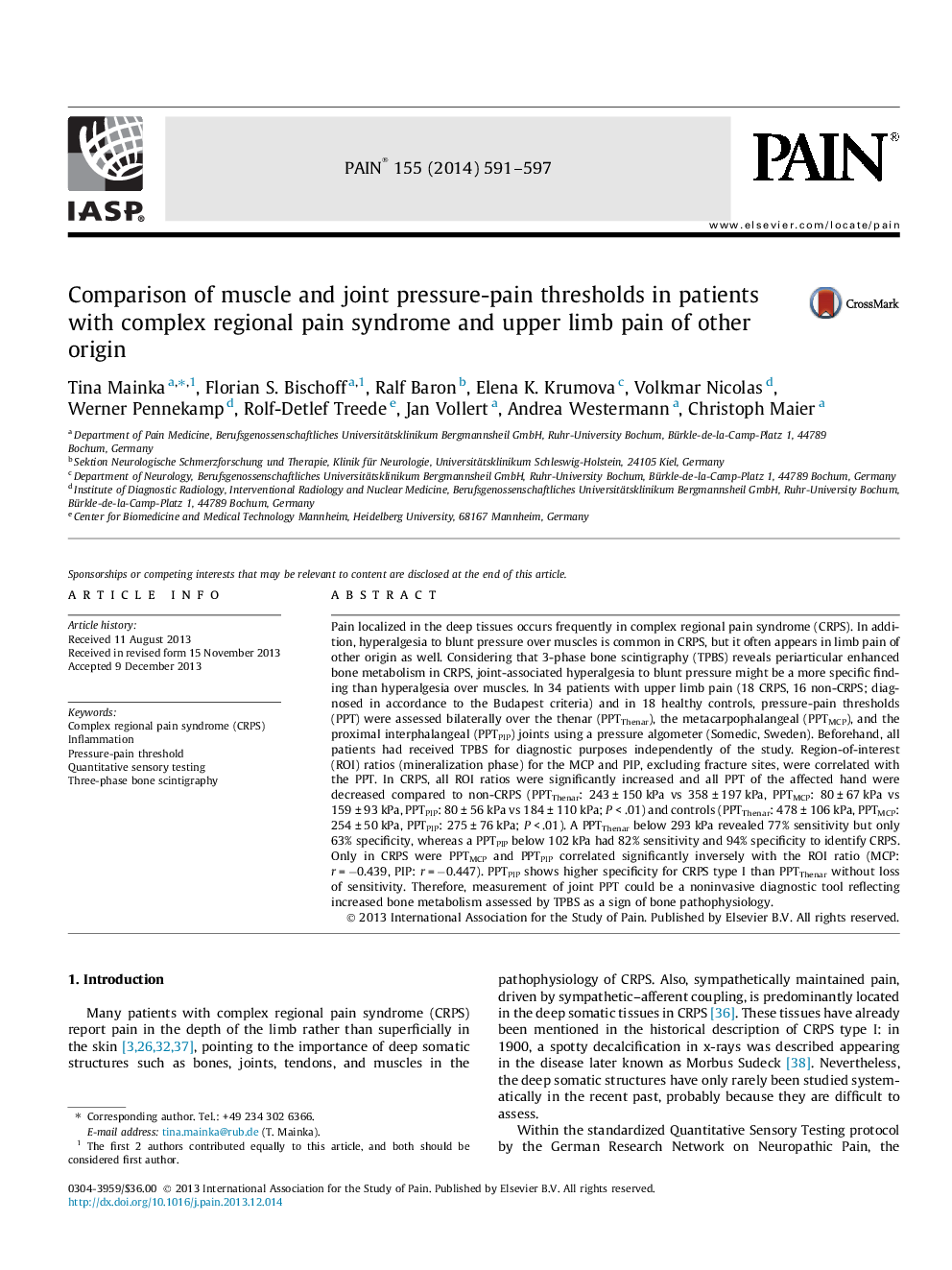| کد مقاله | کد نشریه | سال انتشار | مقاله انگلیسی | نسخه تمام متن |
|---|---|---|---|---|
| 10450091 | 918345 | 2014 | 7 صفحه PDF | دانلود رایگان |
عنوان انگلیسی مقاله ISI
Comparison of muscle and joint pressure-pain thresholds in patients with complex regional pain syndrome and upper limb pain of other origin
ترجمه فارسی عنوان
مقایسه آستانه درد عضلات و فشار مفصلی در بیماران مبتلا به سندرم درد ناحیهای پیچیده و درد اندام دیگری
دانلود مقاله + سفارش ترجمه
دانلود مقاله ISI انگلیسی
رایگان برای ایرانیان
کلمات کلیدی
موضوعات مرتبط
علوم زیستی و بیوفناوری
علم عصب شناسی
علوم اعصاب سلولی و مولکولی
چکیده انگلیسی
Pain localized in the deep tissues occurs frequently in complex regional pain syndrome (CRPS). In addition, hyperalgesia to blunt pressure over muscles is common in CRPS, but it often appears in limb pain of other origin as well. Considering that 3-phase bone scintigraphy (TPBS) reveals periarticular enhanced bone metabolism in CRPS, joint-associated hyperalgesia to blunt pressure might be a more specific finding than hyperalgesia over muscles. In 34 patients with upper limb pain (18 CRPS, 16 non-CRPS; diagnosed in accordance to the Budapest criteria) and in 18 healthy controls, pressure-pain thresholds (PPT) were assessed bilaterally over the thenar (PPTThenar), the metacarpophalangeal (PPTMCP), and the proximal interphalangeal (PPTPIP) joints using a pressure algometer (Somedic, Sweden). Beforehand, all patients had received TPBS for diagnostic purposes independently of the study. Region-of-interest (ROI) ratios (mineralization phase) for the MCP and PIP, excluding fracture sites, were correlated with the PPT. In CRPS, all ROI ratios were significantly increased and all PPT of the affected hand were decreased compared to non-CRPS (PPTThenar: 243 ± 150 kPa vs 358 ± 197 kPa, PPTMCP: 80 ± 67 kPa vs 159 ± 93 kPa, PPTPIP: 80 ± 56 kPa vs 184 ± 110 kPa; P < .01) and controls (PPTThenar: 478 ± 106 kPa, PPTMCP: 254 ± 50 kPa, PPTPIP: 275 ± 76 kPa; P < .01). A PPTThenar below 293 kPa revealed 77% sensitivity but only 63% specificity, whereas a PPTPIP below 102 kPa had 82% sensitivity and 94% specificity to identify CRPS. Only in CRPS were PPTMCP and PPTPIP correlated significantly inversely with the ROI ratio (MCP: r = â0.439, PIP: r = â0.447). PPTPIP shows higher specificity for CRPS type I than PPTThenar without loss of sensitivity. Therefore, measurement of joint PPT could be a noninvasive diagnostic tool reflecting increased bone metabolism assessed by TPBS as a sign of bone pathophysiology.
ناشر
Database: Elsevier - ScienceDirect (ساینس دایرکت)
Journal: PAIN® - Volume 155, Issue 3, March 2014, Pages 591-597
Journal: PAIN® - Volume 155, Issue 3, March 2014, Pages 591-597
نویسندگان
Tina Mainka, Florian S. Bischoff, Ralf Baron, Elena K. Krumova, Volkmar Nicolas, Werner Pennekamp, Rolf-Detlef Treede, Jan Vollert, Andrea Westermann, Christoph Maier,
